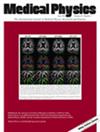Electron beam monitoring of a modified conventional medical accelerator with a portable current transformer system traceable to primary electrical standards
Abstract
Background
Ultra-high dose rate radiotherapy (UHDR) delivers therapeutic doses at rates >40 Gy/s in a fraction of a second, aiming to enhance the therapeutic ratio through the FLASH effect. The substantial increase in UHDR beam current poses serious challenges for conventional active dosimeters. Integrating current transformers (ICT) offer a nondestructive solution for accurate monitoring, enabling the type of fast transient readout that will be crucial for UHDR treatment verification.
Purpose
The aim of this study is to build and characterize a clinically deployable ICT system and to develop an accurate calibration methodology for absolute charge determination that is traceable to primary electrical standards.
Methods
The ICT was constructed from a Super MuMetal® toroid, and its secondary winding was made from 50 Ω coaxial cable. A 3D-printed case with an internal conductive coating shields the toroid assembly from interference. The ICT readout involves a custom differential amplifier and a commercial flash analog-to-digital converter. The system was calibrated using a bespoke sub-µs current pulser in the range of (2 to 16) mA, which itself is traceable to electrical standards via an in-house built electrometer with a calibrated feedback capacitor. The performance of the ICT was evaluated as a milliampere-scale beam monitor against concurrent absorbed dose graphite calorimetry irradiation measurements acquired on a specially tuned medical accelerator for UHDR delivery.
Results
The ICT responses for nominal test pulses, generated by a function generator and a current pulser, exhibited accurate reproduction of rise and fall times within the 1 ns sampling frequency. A systematic droop effect of 0.6(1)%/µs was observed but is accounted for through the calibration chain. The calibration of the current pulser exhibited a repeatability typically better than 0.05%, with a slowly-varying leakage that can be subtracted using a linear regression of the leakage current. The ICT charge calibration demonstrated a repeatability in the range of (0.5 to < 0.05)% for charge per pulse values in the range of (0.5 to 50) nC, respectively. The ICT response showed a strong linear relationship (adj-R2 = 0.99997) to charge per pulse. The in-beam comparison with a graphite calorimeter demonstrated the effectiveness of the ICT as an online beam monitor, independent of pulse repetition frequency in the range of (25 to 200) Hz, reducing the mean excess (i.e., independent of accelerator output) calorimeter variation to 0.3% (0.1% standard error on the mean).
Conclusions
This work demonstrates the feasibility of accurately calibrating the ICT in terms of absolute charge and applying it as a clinically deployable monitoring system of mA-scale electron beams delivered by a medical accelerator.


 求助内容:
求助内容: 应助结果提醒方式:
应助结果提醒方式:


